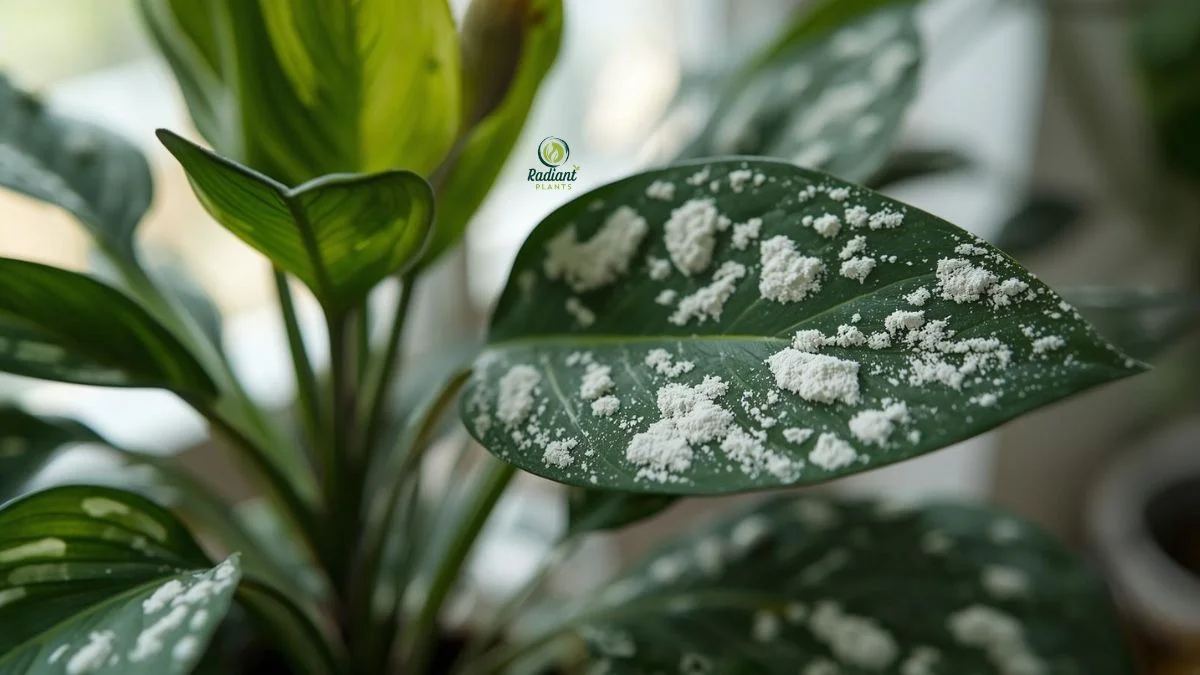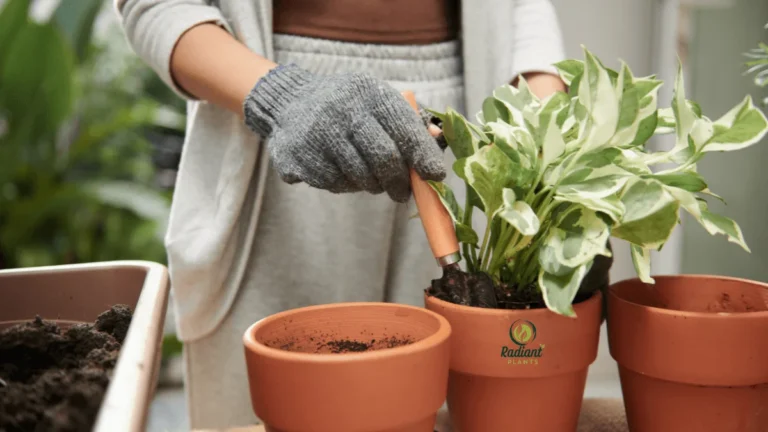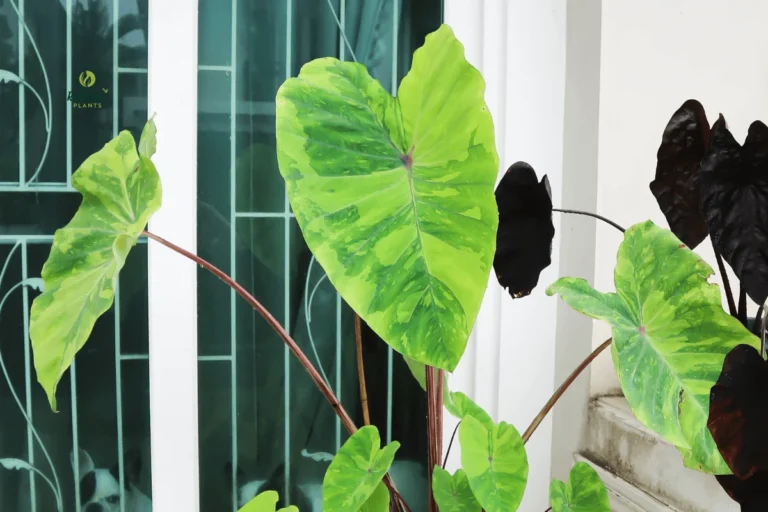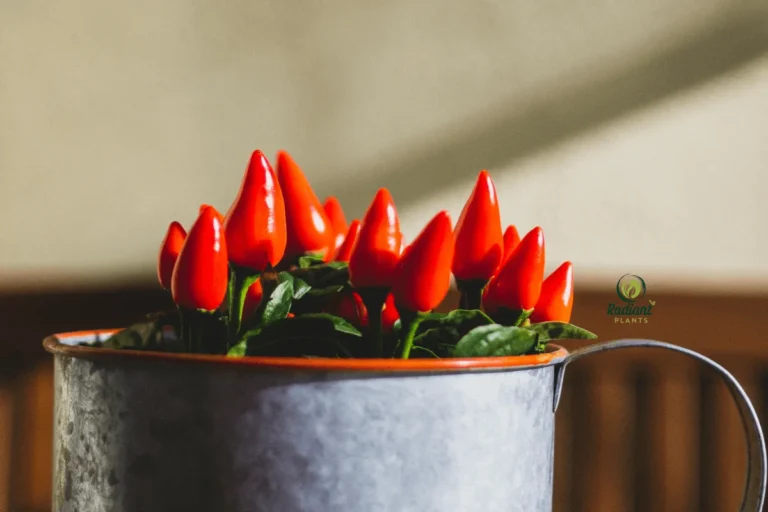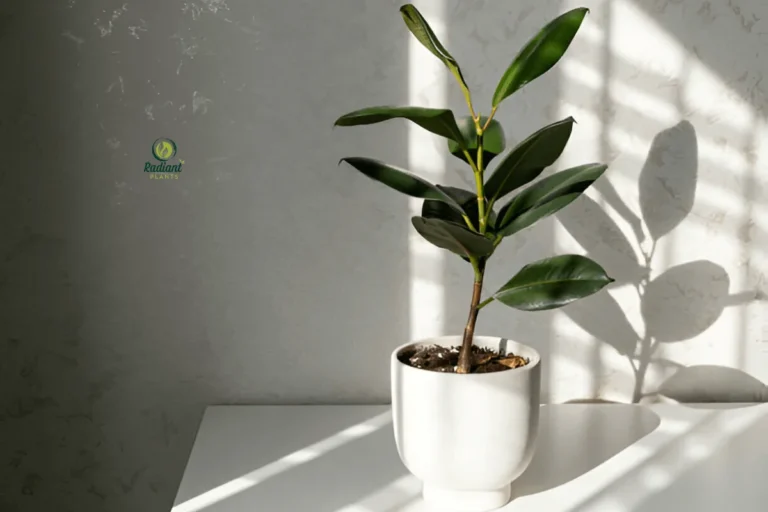White Spots on Plant Leaves: Causes & Easy Fixes
Noticing white spots on your plant leaves and wondering what went wrong? Don’t worry — your green companion isn’t beyond saving. 🌿 These pale marks are actually one of the most common signs that your plant is trying to tell you something — whether it’s a simple buildup of minerals from tap water, a touch of powdery mildew, or tiny pests setting up camp.
In this guide, you’ll learn exactly what causes white spots, how to tell the difference between fungal, pest, and environmental issues, and — most importantly — how to bring your plant’s natural glow back. With a few smart tweaks to your care routine and some gentle, proven remedies, those white speckles will be history in no time.
At Radiant Plants, we believe that understanding your plant’s signals is the key to keeping it lush and vibrant. So, grab your watering can and a soft cloth — let’s uncover what your leaves are trying to say and help your plants shine again. ✨
Table of Contents
Table of Contents
What Causes White Spots on Plant Leaves?
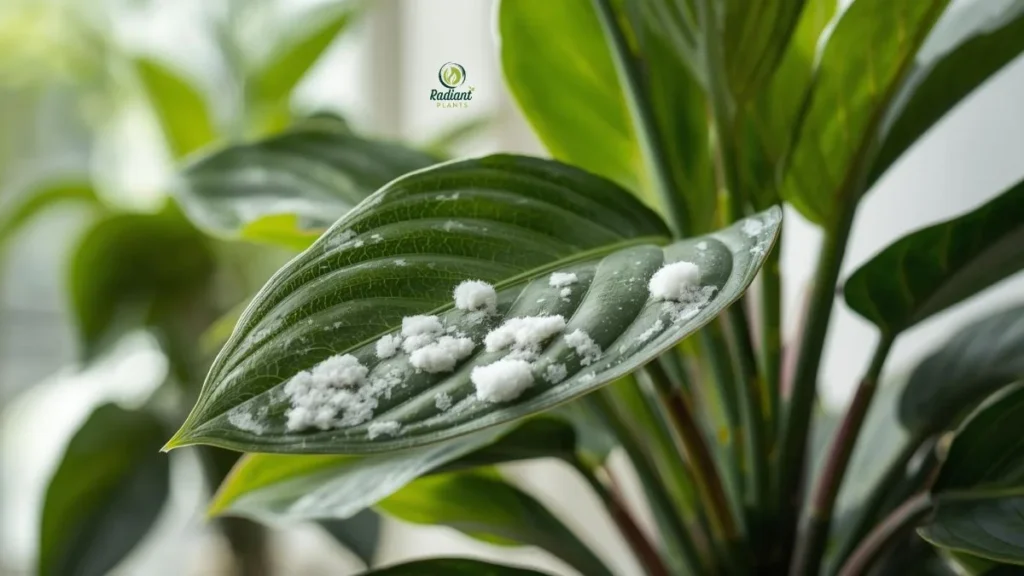
When you start noticing white spots on plant leaves, it’s often a sign that your plant is reacting to something in its environment. These pale marks may look harmless at first, but they can reveal deeper issues — from fungus and pests to mineral residue or too much sun. Understanding the exact cause of white spots on your plant leaves helps you take the right action before the damage spreads.
1. Fungal Infections (Powdery Mildew & Mold)
One of the leading causes of white spots on plant leaves is fungal infection, especially powdery mildew. This fungus looks like a fine, powdery coating — as if someone sprinkled flour over the foliage. It thrives in high humidity, low airflow, and dim light, which makes it common among indoor plants.
To treat it, prune infected leaves and improve air circulation. Wipe foliage with a mild baking soda solution (1 teaspoon per liter of water) or spray with neem oil, a natural fungicide. These simple steps can stop powdery mildew on plants before it spreads further.
(Related: Croton Plant Care: Tips for a Vibrant and Healthy Plant)
2. Pests Like Mealybugs & Spider Mites
Another reason for white spots on plant leaves is tiny sap-sucking pests such as mealybugs or spider mites. Mealybugs create fluffy, cotton-like clusters on stems and leaf joints, while spider mites leave small white dots and silky webbing. Both weaken plants over time by draining nutrients.
Wipe leaves with diluted rubbing alcohol or apply neem oil every few days until the pests disappear completely.
3. Hard Water or Mineral Residue
If the white spots on plant leaves look crusty or chalky, it might just be mineral residue from hard tap water. When water evaporates, it leaves behind calcium and salt deposits. These often appear after misting or watering.
Clean affected leaves with filtered water and a microfiber cloth, and switch to rainwater or distilled water for ongoing care.
4. Sunburn or Light Stress
Sometimes, white spots on plant leaves form because of too much direct light. Sunburned areas turn pale, dry, and patchy — especially on variegated or thin-leaved plants. Unlike disease, these spots don’t spread. Move your plant to a bright but indirect light area to avoid future stress.
(Related: Large Indoor Plants: A Vibrant Guide to Big Green Style)
By identifying what’s behind those white spots on plant leaves, you can tailor your care — whether it’s adjusting humidity, washing residue, or treating a mild infection — and keep your greenery glowing and healthy. 🌿
How to Get Rid of White Spots on Plant Leaves
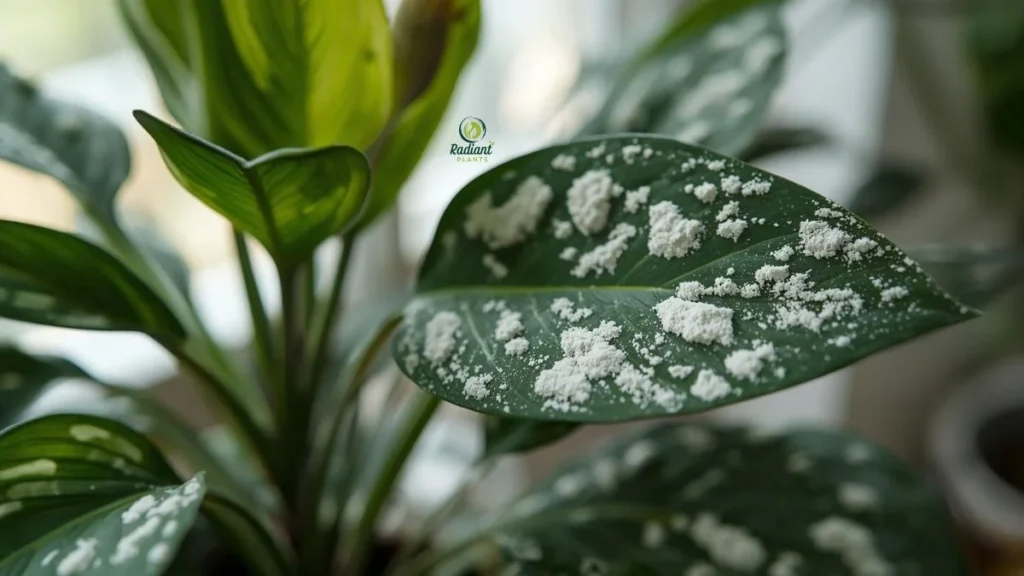
Once you’ve spotted those pale blemishes, the next step is to act quickly — the sooner you treat white spots on plant leaves, the easier it is to restore their natural shine. Here’s a clear, step-by-step approach that plant experts and horticulturists recommend for safely treating white spots while protecting your plant’s overall health.
Step 1 – Diagnose the Type of Spot
Before reaching for any remedy, take a close look at your leaves. Are the white spots on plant leaves powdery and soft, sticky and clustered, or dry and crusty?
- Powdery mildew or mold feels velvety and wipes off easily — a clear fungal sign.
- Pests like mealybugs leave cottony dots or sticky residue, often on the undersides of leaves and stems.
- Mineral deposits from hard water form chalky, non-removable crusts.
Getting this diagnosis right is key — each cause requires a different approach. If you’re unsure, isolate the plant until you identify the problem to prevent it from spreading.
Step 2 – Treat the Problem Safely
Once you know what you’re dealing with, choose a gentle, effective treatment.
- For fungal infections, spray leaves with a natural fungicide for plants, such as a mix of one teaspoon of baking soda and a few drops of liquid soap in a liter of water. Alternatively, use neem oil for houseplants — a proven organic option that works against both fungus and pests.
- For pest infestations, wipe the leaves with diluted rubbing alcohol or insecticidal soap, repeating every few days.
- For mineral residue, clean leaves using filtered or distilled water and a soft cloth to remove buildup.
Always test a small leaf first to avoid damage and continue treatment until the plant fully recovers.
(Related: Root Rot Treatment: 7 Proven Ways to Stop the Spread)
Step 3 – Improve Airflow & Environment
Healthy air circulation and the right environment prevent white spots on plant leaves from coming back. Keep plants spaced apart to improve airflow, reduce humidity levels, and avoid over-misting. Regularly dusting and cleaning leaves also helps photosynthesis and keeps pests at bay.
If your plant is near a drafty window or heat vent, move it to a spot with consistent light and stable temperature — small environmental tweaks make a big difference.
(Related: Dragon Tail Plant Care: The Ultimate Guide to Growing a Thriving Epipremnum)
With consistent care and the right treatment, those stubborn white spots on plant leaves will fade, leaving behind healthy, glossy foliage that reflects the effort you put into your plant’s well-being. 🌿
How to Prevent White Spots on Leaves Before They Start
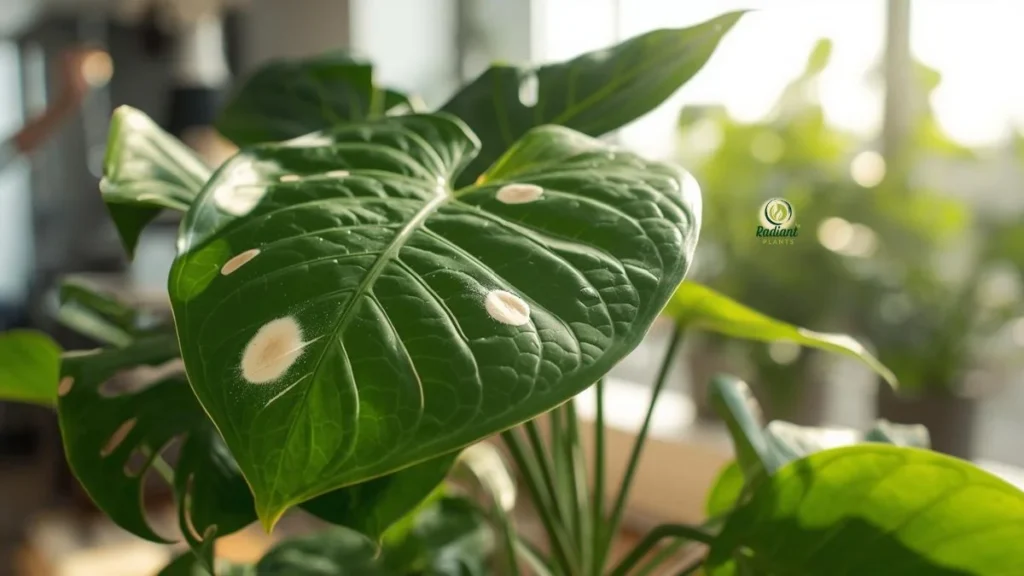
Prevention is always better than cure—especially when it comes to keeping your plant leaves spotless and healthy. 🌿 Once you’ve treated white spots on your plant leaves, the next step is building habits that stop them from coming back. By focusing on your plant’s environment, watering, and hygiene, you’ll create conditions where diseases and pests simply can’t thrive.
Proper Watering Routine (Avoid Leaf Wetness)
Most fungal and bacterial problems start with excess moisture. When watering, direct the stream to the soil rather than the foliage to prevent water from lingering on leaves. Wet leaves—especially in low airflow areas—can invite powdery mildew or mold. Use a watering can with a narrow spout and water early in the morning so any accidental splashes dry quickly.
Balanced Light Exposure
Sunlight helps regulate moisture and keeps leaf surfaces dry, but too much intense light can scorch foliage. Find a bright, indirect light spot where your plants can photosynthesize efficiently without burning. For indoor gardeners, rotating plants weekly ensures even light exposure and healthier, blemish-free leaves.
Air Circulation and Dusting Leaves
Good airflow reduces humidity buildup and keeps fungal spores at bay. Try spacing your plants so air can move freely between them. Gently dust leaves with a soft microfiber cloth or brush to remove dirt that clogs pores and harbors pests. A clean leaf is a happy leaf!
Using Filtered Water or Rainwater
If you notice chalky white residue, it’s often mineral buildup from hard tap water. Using filtered or rainwater helps prevent these spots while keeping leaf surfaces smooth and glossy.
Regular Inspection for Pests
Make it a habit to check the undersides of leaves for spider mites, mealybugs, and scale insects. Early detection prevents infestations that cause white patches and leaf damage.
How do I prevent white spots from returning on my plant leaves?
By maintaining proper watering habits, keeping foliage dry, and improving airflow, you can effectively prevent white spots from reappearing.
Internal Links:
- How to Incorporate Red Plants into Your Interior Spaces
- Easy Ways to Style Your Cane Plant in Any Room
Common Mistakes to Avoid When Treating White Spots
When you spot white marks on your plant leaves, it’s tempting to act fast — but a rushed response can sometimes do more harm than good. 🌿 Many plant lovers unintentionally worsen the problem by using the wrong treatments or ignoring the true cause. Here’s what you should not do when tackling white spots on plant leaves.
Overusing Fungicides or Oils
More isn’t always better. Overapplying fungicides, neem oil, or hydrogen peroxide can clog leaf pores and stress your plant. While these products are effective in moderation, frequent use may cause leaf burn or inhibit growth. Stick to recommended doses, and always test on a small section before applying it widely.
Ignoring the Root Cause (Pests vs. Water Issues)
White spots can stem from multiple sources — fungal spores, pests, or mineral residue. Jumping to conclusions without diagnosing properly often leads to wasted effort. For instance, treating mineral deposits with fungicide won’t work; it only adds unnecessary chemicals. Take time to inspect leaves closely or use a magnifying glass to spot pests like spider mites or mealybugs before deciding on a remedy.
Cleaning Leaves with Harsh Chemicals
Household cleaners or alcohol-based solutions may seem effective, but they can damage delicate foliage. Instead, opt for gentle natural options like diluted neem oil or mild soap water. These safely remove residue while keeping the plant’s surface intact.
Not Pruning Infected Areas
Failing to trim severely affected leaves allows the issue to spread. Always prune damaged leaves with sterilized scissors and discard them away from other plants. This small step dramatically reduces reinfection risk.
Can I wipe white spots off my plant leaves?
Yes — but do it gently with a soft, damp cloth or mild soap solution. Avoid vigorous rubbing or harsh chemicals that might strip the leaf’s protective layer.
Can Plants Recover from White Spots?
The good news is — yes, most plants can recover from white spots on their leaves with the right care and a little patience. 🌿 The key lies in understanding what recovery actually looks like and giving your plant the right conditions to bounce back.
When you notice white spots, the first step is to stop the cause — whether it’s fungus, pests, or mineral buildup. Once that’s handled, focus on encouraging new, healthy growth. It’s important to know that damaged leaves with white scars or discoloration usually won’t turn green again — those marks are permanent. But if your plant starts producing fresh, spotless leaves, it’s a clear sign it’s healing and thriving again.
Patience and Consistency Are Key
Plant recovery isn’t instant. Continue your care routine — gentle cleaning, balanced watering, and indirect light exposure. Avoid the temptation to over-fertilize; too much nutrition can stress a recovering plant. Instead, let it regain strength naturally. Keeping humidity steady and ensuring proper airflow helps prevent further outbreaks of mildew or pest infestations.
When to Repot or Replace Severely Infected Plants
If your plant remains stunted or the infestation keeps coming back, it may be time to repot. Refresh the soil, clean the roots, and choose a sterile pot to remove lingering fungal spores or pest eggs. In extreme cases, where over half the plant is damaged, propagation might be the best way to save it — allowing new, healthy growth to start fresh.
Will white spots on leaves go away on their own?
Not usually. White spots rarely disappear without intervention. Treating the cause and maintaining consistent care are essential for true recovery.
- Red Plants: How to Choose 5 Perfect Interior Options
- Red Sister Plant: The Bold Beauty Your Home Deserves
Propagation After White Spot Damage
If your plant has suffered from white spots on plant leaves, you might wonder whether it’s still possible to propagate it successfully. The good news is yes, but success depends on careful selection and proper hygiene. Propagating from infected plants is safe only if you choose healthy, unaffected cuttings and follow the right steps. 🌿
Choose Healthy Cuttings
Always select leaves or stems that show no signs of white spots, discoloration, or pests. Even a single infected section can carry fungal spores or pests into new plants, compromising your propagation efforts. Look for firm, vibrant growth with healthy nodes — this is your best chance for a thriving new plant.
Disinfect Tools and Prune Properly
Before cutting, disinfect your pruning shears or scissors with rubbing alcohol or a mild bleach solution. Trim away any damaged or spotted leaves first, then take your cuttings from the healthy sections. Clean tools prevent the transfer of pathogens and ensure your propagated plants start in a safe, disease-free environment.
Planting and Care for New Cuttings
Use a sterile potting medium suited to the plant type, and keep humidity consistent while avoiding overwatering. Bright, indirect light encourages root development without stressing your cutting. Regularly inspect your propagated plant for early signs of white spots or pests, so any issues can be addressed quickly.
By following these plant propagation tips and focusing on healthy sections, even a plant that suffered from white spots can give you new, vibrant growth. 🌱 With care and patience, propagation can help you salvage and expand your collection.
- Alum Serendipity Plant: The Secret to a Stunning Garden
- White Princess Philodendron: Grow & Care Guide for Success
FAQs for white spots on plant leaves
How do you get rid of white spots on plants?
To get rid of white spots on plants, first identify the cause: fungal, pest, or mineral residue. For powdery mildew, prune affected leaves and spray with a natural fungicide or neem oil. For pests, wipe leaves with diluted rubbing alcohol or insecticidal soap. Mineral residue can be removed using filtered water and a soft cloth. Improving airflow and light helps prevent recurrence.
Do plants recover from powdery mildew?
Yes, plants can recover from powdery mildew with proper care. Remove infected leaves, treat with organic fungicides like neem oil, and improve air circulation and sunlight exposure. While damaged leaves may not fully return to normal, new growth will be healthy if the environment is adjusted. Consistent care and early intervention are key to full recovery.
What deficiency causes white spots on leaves?
White spots on leaves are often linked to calcium or magnesium deficiency, which can cause chlorotic or pale patches. Hard water or nutrient-poor soil may contribute. To correct this, use a balanced fertilizer or calcium-magnesium supplement, ensure proper watering practices, and monitor the plant regularly. Maintaining healthy soil and consistent care prevents further discoloration.
Why do indoor plant leaves get white spots?
White spots on plant leaves can appear due to fungal infections like powdery mildew, pests such as mealybugs, mineral residue from hard water, or light stress. Identifying the exact cause is key to treating the issue effectively. Regular inspection, proper watering, and clean leaves help prevent these problems.
Can white spots on leaves go away on their own?
Typically, white spots on plant leaves do not disappear without intervention. Fungal spores, pest infestations, and mineral buildup require treatment to prevent further spread. Use gentle remedies like neem oil or natural fungicides, remove severely affected leaves, and adjust environmental factors to encourage healthy, new growth.
Internal links: Dragon Tail Plant Care
How can I safely remove white spots from leaves?
Gently wipe leaves with a soft cloth and filtered water, or apply mild soap and water for stubborn residue. Avoid harsh chemicals that can damage foliage. For fungal or pest issues, use a natural fungicide for plants or neem oil, ensuring you treat only the affected areas to protect healthy leaves.
Internal links: White Princess Philodendron Care
How do I prevent white spots from returning on my plants?
Preventing white spots involves proper watering routines, maintaining indirect light, improving airflow, and inspecting leaves regularly for pests. Using filtered or rainwater can prevent mineral buildup, while routine dusting keeps leaves clean and photosynthesizing efficiently. Consistency is key to avoiding repeat issues.
Internal links: Easy Ways to Style Your Cane Plant
Can pests cause white spots on plant leaves?
Yes! Pests like mealybugs, spider mites, and scale insects leave white cottony spots or sticky residue. They weaken the plant by sucking sap, which can also encourage fungal growth. Early detection and treatment with neem oil or insecticidal soap helps maintain healthy foliage.
Internal links: Root Rot Treatment
Dealing with white spots on plant leaves doesn’t have to be stressful. By identifying the cause — whether fungal, pest-related, mineral buildup, or light stress — and applying the right treatment, you can restore your plant’s health and beauty. Consistent care, proper watering, good airflow, and regular inspections are key to keeping leaves vibrant and spotless.
Healthy leaves not only enhance your plant’s appearance but also improve photosynthesis, ensuring stronger growth and a thriving indoor garden. Remember, patience and careful observation go a long way — new, healthy leaves are the reward for your attention and dedication.
Ready to take your plant care to the next level? Explore our expert tips on other stunning houseplants to expand your indoor oasis. 🌿 Read our guide on White Princess Philodendron: Grow & Care Guide for Success for more inspiration and practical advice. With the right strategies, your plants can flourish, free of white spots, and fill your home with lush, vibrant greenery.

